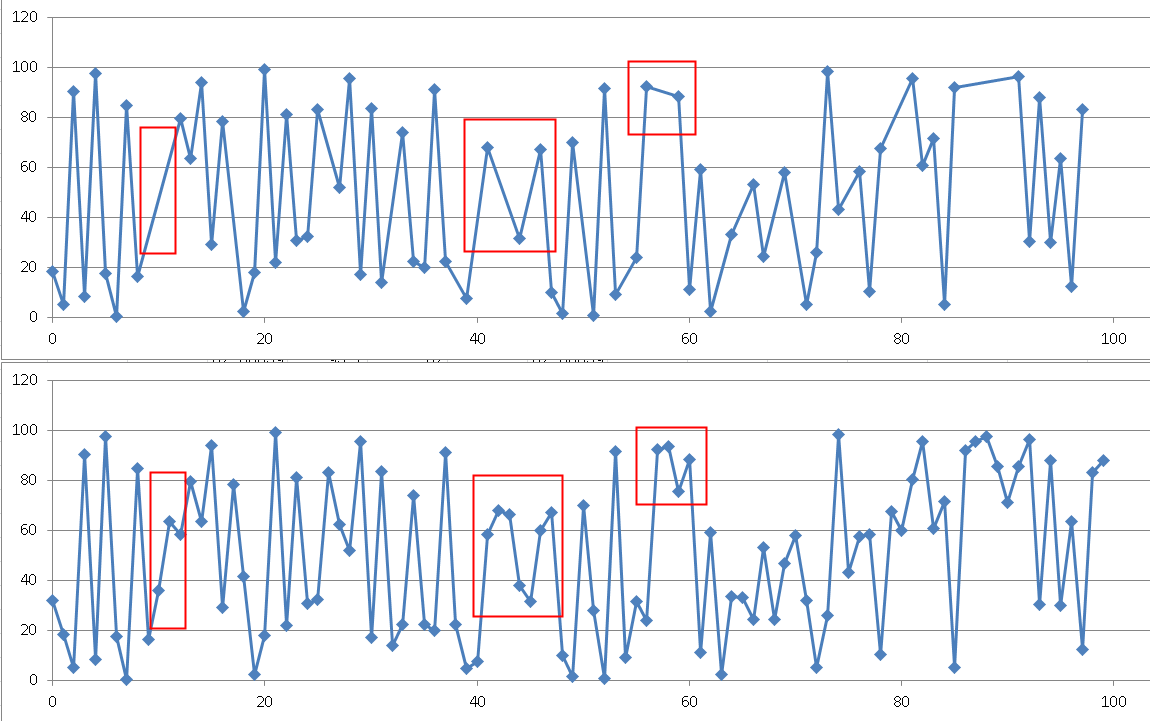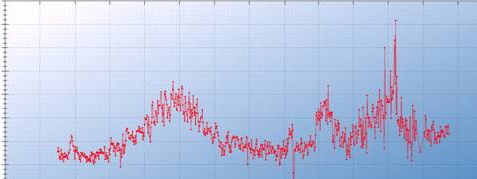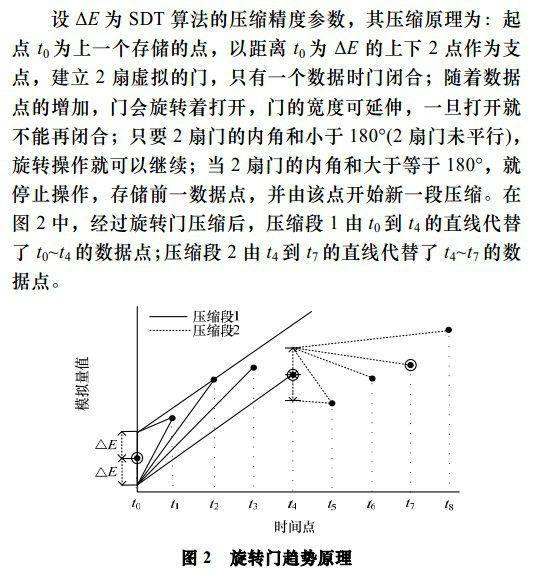create table tbl(id int, -- ID,可有可无
val numeric, -- 值(如传感器或金融行业的点值)
t timestamp -- 取值时间戳
插入10万条测试数据
insert into tbl select generate_series(1,100000), round((random()*100)::numeric, 2), clock_timestamp()+(generate_series(1,100000) || ' second')::interval ;
test=> select * from tbl limit 10;
id | val | t
----+-------+----------------------------
1 | 31.79 | 2016-08-12 23:22:27.530318
2 | 18.23 | 2016-08-12 23:22:28.530443
3 | 5.14 | 2016-08-12 23:22:29.530453
4 | 90.25 | 2016-08-12 23:22:30.530459
5 | 8.17 | 2016-08-12 23:22:31.530465
6 | 97.43 | 2016-08-12 23:22:32.53047
7 | 17.41 | 2016-08-12 23:22:33.530476
8 | 0.23 | 2016-08-12 23:22:34.530481
9 | 84.67 | 2016-08-12 23:22:35.530487
10 | 16.37 | 2016-08-12 23:22:36.530493
(10 rows)
时间如何转换成X轴的数值,假设每1秒为X坐标的1个单位
test=> select (extract(epoch from t)-extract(epoch from first_value(t) over())) / 1 as x, -- 除以1秒为1个单位
val, t from tbl limit 100;
x | val | t
------------------+-------+----------------------------
0 | 31.79 | 2016-08-12 23:22:27.530318
1.00012493133545 | 18.23 | 2016-08-12 23:22:28.530443
2.00013494491577 | 5.14 | 2016-08-12 23:22:29.530453
3.00014090538025 | 90.25 | 2016-08-12 23:22:30.530459
4.00014686584473 | 8.17 | 2016-08-12 23:22:31.530465
5.00015187263489 | 97.43 | 2016-08-12 23:22:32.53047
6.00015807151794 | 17.41 | 2016-08-12 23:22:33.530476
7.00016307830811 | 0.23 | 2016-08-12 23:22:34.530481
8.00016903877258 | 84.67 | 2016-08-12 23:22:35.530487
编写实现螺旋门算法的函数
create or replace function f (
i_radius numeric, -- 压缩半径
i_time timestamp, -- 开始时间
i_interval_s numeric, -- 时间转换间隔 (秒,例如每5秒在坐标上表示1个单位间隔,则这里使用5)
query text, -- 需要进行旋转门压缩的数据, 例子 'select t, val from tbl where t>=%L order by t limit 100' , select 子句必须固定, 必须按t排序
OUT o_val numeric, -- 值,纵坐标 y (跳跃点y)
OUT o_time timestamp, -- 时间,横坐标 x (跳跃点x)
OUT o_x numeric -- 跳跃点x, 通过 o_time 转换
returns setof record as
declare
v_time timestamp; -- 时间变量
v_x numeric; -- v_time 转换为v_x
v_val numeric; -- y坐标
v1_time timestamp; -- 前一点 时间变量
v1_x numeric; -- 前一点 v_time 转换为v_x
v1_val numeric; -- 前一点 y坐标
v_start_time numeric; -- 记录第一条的时间坐标, 用于计算x偏移量
v_rownum int8 := 0; -- 用于标记是否第一行
v_max_angle1 numeric; -- 最大上门夹角角度
v_max_angle2 numeric; -- 最大下门夹角角度
v_angle1 numeric; -- 上门夹角角度
v_angle2 numeric; -- 下门夹角角度
begin
for v_time , v_val in execute format(query, i_time)
-- 第一行,第一个点,是实际要记录的点位
v_rownum := v_rownum + 1;
if v_rownum=1 then
v_start_time := extract(epoch from v_time);
v_x := 0;
o_val := v_val;
o_time := v_time;
o_x := v_x;
-- raise notice 'rownum=1 %, %', o_val,o_time;
return next; -- 返回第一个点
v_x := (extract(epoch from v_time) - v_start_time) / i_interval_s; -- 生成X坐标
SELECT 180-ST_Azimuth(
ST_MakePoint(o_x, o_val+i_radius), -- 门上点
ST_MakePoint(v_x, v_val) -- next point
)/(2*pi())*360 as degAz, -- 上夹角
ST_Azimuth(
ST_MakePoint(o_x, o_val-i_radius), -- 门下点
ST_MakePoint(v_x, v_val) -- next point
)/(2*pi())*360 As degAzrev -- 下夹角
INTO v_angle1, v_angle2;
select GREATEST(v_angle1, v_max_angle1), GREATEST(v_angle2, v_max_angle2) into v_max_angle1, v_max_angle2;
if (v_max_angle1 + v_max_angle2) >= 180 then -- 找到四边形外的点位,输出上一个点,并从上一个点开始重新计算四边形
-- raise notice 'max1 %, max2 %', v_max_angle1 , v_max_angle2;
-- 复原
v_angle1 := 0;
v_max_angle1 := 0;
v_angle2 := 0;
v_max_angle2 := 0;
-- 门已完全打开,输出前一个点的值
o_val := v1_val;
o_time := v1_time;
v1_x := (extract(epoch from v1_time) - v_start_time) / i_interval_s; -- 生成前一个点的X坐标
o_x := v1_x;
-- 用新的门,与当前点计算新的夹角
SELECT 180-ST_Azimuth(
ST_MakePoint(o_x, o_val+i_radius), -- 门上点
ST_MakePoint(v_x, v_val) -- next point
)/(2*pi())*360 as degAz, -- 上夹角
ST_Azimuth(
ST_MakePoint(o_x, o_val-i_radius), -- 门下点
ST_MakePoint(v_x, v_val) -- next point
)/(2*pi())*360 As degAzrev -- 下夹角
INTO v_angle1, v_angle2;
select GREATEST(v_angle1, v_max_angle1), GREATEST(v_angle2, v_max_angle2) into v_max_angle1, v_max_angle2;
-- raise notice 'new max %, new max %', v_max_angle1 , v_max_angle2;
-- raise notice 'rownum<>1 %, %', o_val, o_time;
return next;
end if;
-- 记录当前值,保存作为下一个点的前点
v1_val := v_val;
v1_time := v_time;
end if;
END LOOP;
language plpgsql strict;
门宽为15,起始时间为'2016-08-12 23:22:27.530318',每1秒表示1个X坐标单位。
test=>
select * from f (
15, -- 门宽度=15
'2016-08-12 23:22:27.530318', -- 开始时间
1, -- 时间坐标换算间隔,1秒
'select t, val from tbl where t>=%L order by t limit 100' -- query
o_val | o_time | o_x
-------+----------------------------+------------------
18.23 | 2016-08-12 23:22:28.530443 | 0
5.14 | 2016-08-12 23:22:29.530453 | 1.00001287460327
90.25 | 2016-08-12 23:22:30.530459 | 2.00001883506775
......
87.90 | 2016-08-12 23:24:01.53098 | 93.0005400180817
29.94 | 2016-08-12 23:24:02.530985 | 94.0005450248718
63.53 | 2016-08-12 23:24:03.53099 | 95.0005497932434
12.25 | 2016-08-12 23:24:04.530996 | 96.0005559921265
83.21 | 2016-08-12 23:24:05.531001 | 97.0005609989166
(71 rows)
可以看到100个点,压缩成了71个点。
对比一下原来的100个点的值
test=> select val, t, (extract(epoch from t)-extract(epoch from first_value(t) over()))/1 as x from tbl where t>'2016-08-12 23:22:27.530318' order by t limit 100;
val | t | x
-------+----------------------------+------------------
18.23 | 2016-08-12 23:22:28.530443 | 0
5.14 | 2016-08-12 23:22:29.530453 | 1.00001001358032
90.25 | 2016-08-12 23:22:30.530459 | 2.0000159740448
......
83.21 | 2016-08-12 23:24:05.531001 | 97.0005581378937
87.97 | 2016-08-12 23:24:06.531006 | 98.0005631446838
58.97 | 2016-08-12 23:24:07.531012 | 99.0005691051483
(100 rows)
使用excel绘图,进行压缩前后的对比
上面是压缩后的数据绘图,下面是压缩前的数据绘图
红色标记的位置,就是通过旋转门算法压缩掉的数据。
失真度是可控的。

流式压缩的实现
本文略,其实也很简单,这个函数改一下,创建一个以数组为输入参数的函数。
以lambda的方式,实时的从流式输入的管道取数,并执行即可。
也可以写成聚合函数,在基于PostgreSQL 的流式数据库pipelineDB中调用,实现流式计算。
http://www.pipelinedb.com/
通过旋转门算法,对IT监控、金融、电力、水利等监控、物联网、等流式数据进行实时的压缩。
数据不需要从数据库LOAD出来即可在库内完成运算和压缩。
用户也可以根据实际的需求,进行流式的数据压缩,同样数据也不需要从数据库LOAD出来,在数据库端即可完成。
PostgreSQL的功能一如既往的强大,好用,快用起来吧。
http://baike.baidu.com/view/3478397.htm
http://postgis.net/docs/manual-2.2/ST_Azimuth.html
https://www.postgresql.org/docs/devel/static/functions-conditional.html
http://gis.stackexchange.com/questions/25126/how-to-calculate-the-angle-at-which-two-lines-intersect-in-postgis
http://gis.stackexchange.com/questions/668/how-can-i-calculate-the-bearing-between-two-points-in-postgis
http://www.pipelinedb.com/
扩展阅读,用心感受PostgreSQL
《找对业务G点, 体验酸爽 - PostgreSQL内核扩展指南》
https://yq.aliyun.com/articles/55981
《当物流调度遇见PostgreSQL - GIS, 路由, 机器学习 (狮子,女巫,魔衣橱)》
https://yq.aliyun.com/articles/57857
《弱水三千,只取一瓢,当图像搜索遇见PostgreSQL (Haar wavelet)》
https://yq.aliyun.com/articles/58246
《用PostgreSQL支持含有更新,删除,插入的实时流式计算》
https://yq.aliyun.com/articles/30985
《PostgreSQL 内核扩展之 - 管理十亿级3D扫描数据》
https://yq.aliyun.com/articles/57095
《PostgreSQL 内核扩展之 - ElasticSearch同步插件》
https://yq.aliyun.com/articles/56824
《为了部落 - 如何通过PostgreSQL基因配对,产生优良下一代》
https://yq.aliyun.com/articles/55869
《PostgreSQL 结巴分词》
https://yq.aliyun.com/articles/58007
《PostgreSQL 如何高效解决 按任意字段分词检索的问题 - case 1》
https://yq.aliyun.com/articles/58006
《mongoDB BI 分析利器 - PostgreSQL FDW (MongoDB Connector for BI)》
https://yq.aliyun.com/articles/57987
《关键时刻HINT出彩 - PG优化器的参数如何优化、执行计划如何固化》
https://yq.aliyun.com/articles/57945
《PostgreSQL Oracle兼容性之 - 锁定执行计划 (Outline system)》
https://yq.aliyun.com/articles/57999
《使用PostgreSQL 流复制decode 对接kafka,实现数据跨应用融合》
http://www.confluent.io/blog/bottled-water-real-time-integration-of-postgresql-and-kafka/
场景与优化
《PostgreSQL 如何潇洒的处理每天上百TB的数据增量》
https://yq.aliyun.com/articles/8528
《PostgreSQL 秒杀场景优化》
https://yq.aliyun.com/articles/3010
《PostgreSQL独孤九式搞定物联网》
https://yq.aliyun.com/articles/52405
《PostgreSQL 用CPU "硬解码" 提升1倍 数值运算能力 助力金融大数据量计算》
https://yq.aliyun.com/articles/7482
《PostgreSQL 百亿数据 秒级响应 正则及模糊查询》
https://yq.aliyun.com/articles/7444
《PostgreSQL 1000亿数据量 正则匹配 速度与激情》
https://yq.aliyun.com/articles/7549
《PostgreSQL 百亿地理位置数据 近邻查询性能优化》
https://yq.aliyun.com/articles/2999
大数据实践
《Greenplum 数据分布黄金法则 - 论分布列与分区的选择》
https://yq.aliyun.com/articles/57822
《阿里云ApsaraDB RDS用户 - OLAP最佳实践》
https://yq.aliyun.com/articles/57778
《Greenplum 资源隔离的原理与源码分析》
https://yq.aliyun.com/articles/57763
《PostgreSQL 多维分析 CASE》
https://yq.aliyun.com/articles/53750
《一致性哈希在分布式数据库中的应用探索》
https://yq.aliyun.com/articles/57954
《PostgreSQL 9.5新特性 width_bucket 位置插值,展示柱状图》
https://yq.aliyun.com/articles/2642
《PostgreSQL 9.5 新特性 高斯(正态)分布和指数分布 数据生成器》
https://yq.aliyun.com/articles/2639
《一个简单算法可以帮助物联网,金融 用户 节约98%的数据存储成本》
https://yq.aliyun.com/articles/18042
《开源数据库 PostgreSQL 攻克并行计算难题》
https://yq.aliyun.com/articles/44655
《PostgreSQL 并行计算 - 助力实时精准营销应用》
https://yq.aliyun.com/articles/44649
《PostgreSQL 计算 任意类型 字段之间的线性相关性》
https://yq.aliyun.com/articles/18038
《HLL 估值算法在PostgreSQL大数据 估值计算中的应用》
http://blog.163.com/digoal@126/blog/static/16387704020131264480325/
http://blog.163.com/digoal@126/blog/static/1638770402013127917876/
http://blog.163.com/digoal@126/blog/static/16387704020131288553810/
《PostgreSQL 流式计算数据库pipelineDB》
http://www.pipelinedb.com/
《固若金汤 - PostgreSQL pgcrypto加密插件》
https://yq.aliyun.com/articles/58377
《PostgreSQL 物联网黑科技 - 瘦身500倍的索引(范围索引 BRIN)》
https://yq.aliyun.com/articles/27860
《PostgreSQL 物联网黑科技 - 阅后即焚》
https://yq.aliyun.com/articles/27722
《如何用PostgreSQL解决一个人工智能 语义去重 的小问题》
https://yq.aliyun.com/articles/25899
《PostgreSQL 老湿机图解平安科技遇到的垃圾回收"坑",及解法》
https://yq.aliyun.com/articles/57710
《PostgreSQL雕虫小技,分组TOP性能提升44倍》
https://yq.aliyun.com/articles/57315
《PostgreSQL 9.6 黑科技 bloom 算法索引,一个索引支撑任意列组合查询》
https://yq.aliyun.com/articles/51131
《PostgreSQL 9.6 攻克金融级多副本可靠性问题》
https://yq.aliyun.com/articles/45518
《distinct xx和count(distinct xx)的 变态优化方法》
https://yq.aliyun.com/articles/39689
《PostgreSQL 百亿级数据范围查询, 分组排序窗口取值 变态优化 case》
https://yq.aliyun.com/articles/39680
《中文模糊查询性能优化 by PostgreSQL trgm》
https://yq.aliyun.com/articles/39033
《PostgreSQL Oracle兼容性之 - connect by》
https://yq.aliyun.com/articles/54657
《论云数据库编程能力的重要性》
https://yq.aliyun.com/articles/38377
《使用sysbench测试阿里云RDS PostgreSQL性能》
https://yq.aliyun.com/articles/35517
《PostgreSQL merge json的正确姿势》
https://yq.aliyun.com/articles/54646
《PostgreSQL 在路上的特性 - 远离触发器, 拥抱内置分区》
https://yq.aliyun.com/articles/54456
《PostgreSQL 如何轻松搞定行驶、运动轨迹合并和切分》
https://yq.aliyun.com/articles/54445
《在PostgreSQL中如何生成kmean算法的测试数据》
https://yq.aliyun.com/articles/53992
《在PostgreSQL中如何生成线性相关的测试数据》
https://yq.aliyun.com/articles/53993
内核探索
《PostgreSQL plan cache 源码浅析 - 如何确保不会计划倾斜》
https://yq.aliyun.com/articles/55719
《为什么用 PostgreSQL 绑定变量 没有 Oracle pin S 等待问题》
https://yq.aliyun.com/articles/55698
《PostgreSQL 同步流复制原理和代码浅析》
https://yq.aliyun.com/articles/55676
《深入浅出PostgreSQL B-Tree索引结构》
https://yq.aliyun.com/articles/53701
《PostgreSQL 可靠性和一致性 代码分析》
https://yq.aliyun.com/articles/37395
《PostgreSQL HOT技术》
src/backend/access/heap/README.HOT
《PostgreSQL B-Tree GIN GIST SP-GIST BRIN HASH索引内部结构》
https://www.pgcon.org/2016/schedule/attachments/434_Index-internals-PGCon2016.pdf
更多内容请访问
云栖PostgreSQL圈子
https://yq.aliyun.com/groups/29
云栖Greenplum圈子
https://yq.aliyun.com/groups/13
ApsaraDB 数据库内核组月报(涵盖MySQL PostgreSQL Greenplum mongoDB 等数据库引擎)
http://mysql.taobao.org/monthly/
我的BLOG
http://blog.163.com/digoal@126
我的git
https://github.com/digoal
祝大家玩得开心,欢迎随时来 阿里云促膝长谈业务需求 ,恭候光临。
阿里云的小伙伴们加油,努力 做好内核与服务,打造最贴地气的云数据库 。
知识点:时序数据特性,SCHEMAless设计思路,递归调用,规则,流式计算,滑窗聚合
1、时序数据合并场景加速分析和实现 - 复合索引,窗口分组查询加速,变态递归加速背景: 在很多场景中,都会有数据合并的需求。


